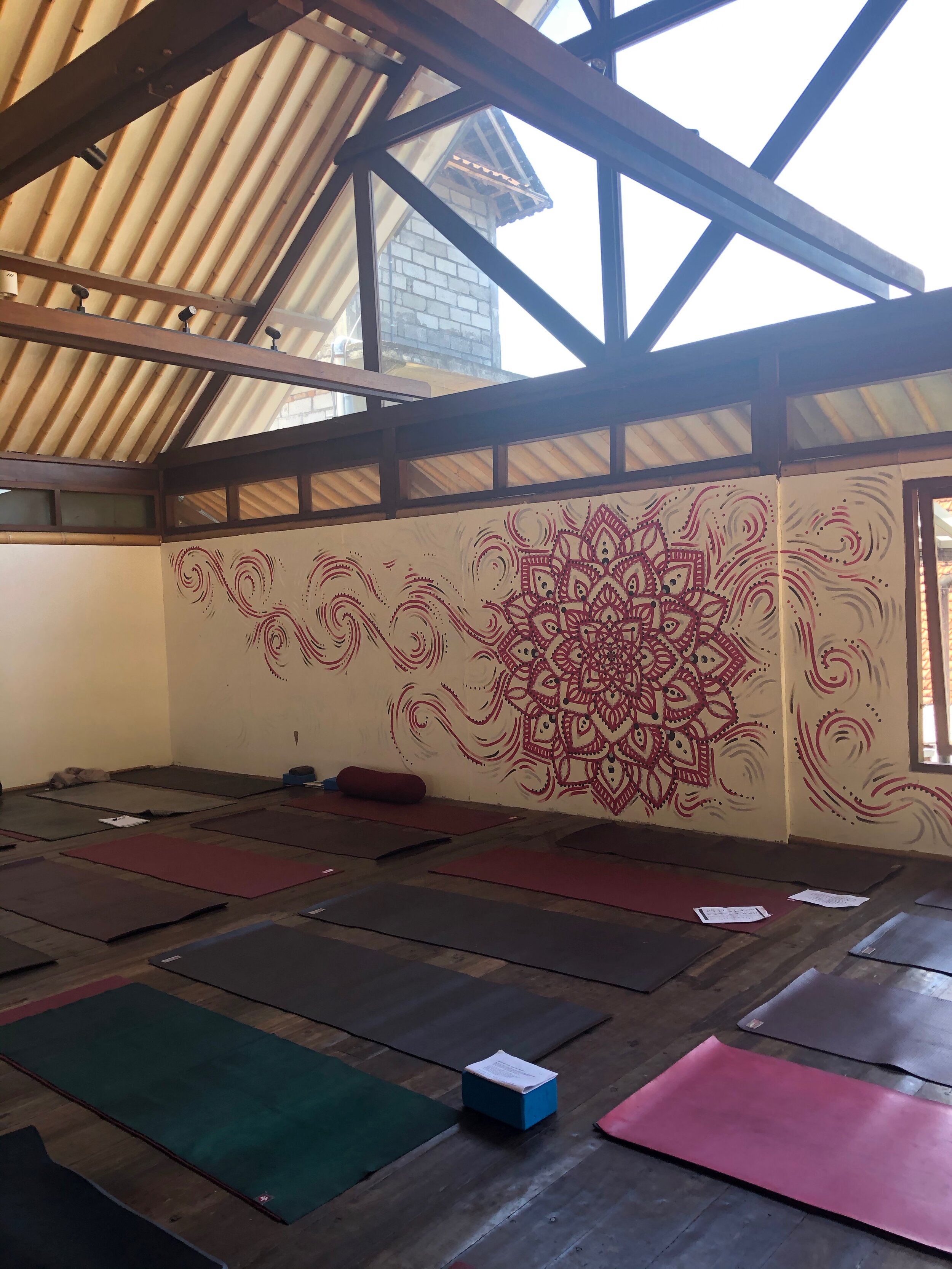Yoga Workshop Day 2
I started taking yoga classes when I was 19 or 20. I was in college and it was just for fun. I remember learning from an older guy named Bill at the University of Delaware gym. My friend Annie and I would go and try to contain our laughter while he instructed us in partner poses and I would, more often than not, fall asleep in savasana. It felt relaxing and silly and like a perfectly lighthearted introduction to yoga.
The next year I started going more regularly. First two or three days a week, which eventually built up to five days. It started with Hatha yoga, where I learned slow movement, breath, and extended holds. I ventured outside the school gym to a studio down the street to learn Bikram. I liked how the heated room opened up my muscles that were tight from working out and playing volleyball. But I grew bored of repeating the same 26 poses every day. When I traveled to New York on breaks, I found a favorite studio and teacher back home. She was a former dancer who blended the foundations of yoga with creative sequencing. I fell in love with the fluid movement of vinyasa.
When I moved to Austin in 2013, I found that I could have it all. I joined a Bikram-based studio near my apartment that also offered other styles. Yoga gave me a feeling of home and sense of community in a new city. It was the same year that ClassPass started, and in the beginning an unlimited package of classes was unbelievably affordable. I tried just about every yoga studio in the city. I found my favorites (still BFree, Dharma, and Practice) and learned more and more. The quality of teachers and variety of classes made it easy for me to go every day, sometimes more than once a day.
I completed my first teacher training at Dharma and began teaching wherever I could. My long-time boyfriend abruptly ended our relationship and I cried in a lot of classes, seeking peace on the mat. By early 2018 during my last weeks in Austin, I was work-trading at BFree in exchange for a membership and taking two or three classes every day. My practice felt stronger than ever, and I was teaching two or three times a week.
Flash forward to Los Angeles, I was in deep. I completed my 500-hour advanced teacher training with YogaWorks and taught 10-15 classes a week. Keep in mind that 10-15 classes weekly isn’t even a full-time yoga teaching schedule for a new-ish/non-famous teacher—many teach up to 25! I was working other jobs as well. I was so grateful for the opportunity to teach and to learn from my mentor, Heather Seiniger, along with some other wonderful teachers in LA, but by the end of it all, I felt burnt out in my mind and worn out in my body.
In this week’s workshop with Kino MacGregor, we’ve been discussing the Yoga Sutras. These 196 sutras, or truths/statements, explain the basis of the philosophy of yoga. Historically, a person in India would have to memorize them all (!!!) in order to demonstrate that they were ready to begin the practice of yoga. Now, every teacher training covers them, but we’re only required to memorize about 3-5. I’m enjoying studying them more deeply with Kino because she has a deep knowledge of sanskrit, so we go through each word and break down the translation. I love learning languages, and it helps me to understand the full meaning when I can see the roots in a word.
On day two of the workshop, we talked about Sutra 1.14, which tells us the three necessary qualities of a yoga practice:
Practice becomes firmly established when it has been cultivated uninterruptedly and with devotion over a prolonged period of time.
Kino explained further that a solid yoga practice contains three elements:
For a long time- A “long time” can mean different things, but in this case it’s one human lifetime. No biggie.
Uninterrupted- Kino says six days a week for at least five minutes a day.
With devotion- Your intention matters. Why are you on the mat? Why are you practicing?
2019 was the first time that I took any significant breaks from taking yoga classes. During months that I was working and teaching a lot, I sometimes couldn’t find the motivation to drive to a class or do a whole video sequence. When I moved to Sydney, I got back on the horse and began a physically intense Ashtanga practice, but by the end of the year I found that pushing through old injuries and being so hard on my body was catching up to me. I needed to rest.
January 2020 has seen a slow start for my yoga. I haven’t taught a class since October, and my daily practice has often been rolling around on the floor or seated meditation. My mind doesn’t know what to do. Is the rest appropriate, or am I being lazy? Is Ashtanga not right for me, or have I been doing it wrong? Am I still a teacher if I take a break? What should my practice look like now?
This month I’ve been seeking out the answers. The love and devotion is still in my heart, but there has definitely been some interruption. I’m glad Kino mentioned that 5 minutes a day is enough, because that’s about all I’ve been able to muster so far this year. She also told us that it’s important to take a sabbatical from teaching every few years, and I’ve certainly appreciated that. Since October, I’ve been able to be a regular student from some of the best teachers in the world, and now I feel lit on fire, eager to share all I’ve learned. (starting in El Salvador next month!)
I’m also ready to return to a more balanced practice. This week in Bali has felt incredibly healing—thanks to breath work, chakra balancing, massage, and trauma release (I’m spoiled. I know)— and I miss the sweat and power of using my muscles within their limits. I don’t think I’ll go back to taking three classes a day while demonstrating poses alongside my students. But after a sweet period of recovery, it feels right to continue my yoga practice for the rest of this one human lifetime.
If you made it this far, thank you for reading. <3
Namaste.
First Days
Today was my first day at school and we spent it doing 8 hours of arts & crafts, so I think you could say that I'm on the right path.
But all fun, cheetah borders, and elephant-shaped die-cutters aside, changing jobs is like entering a weird, alternate universe type time warp where you can never feel too sure if you're doing the right thing. No matter how deep your roots have grown, it can be unbalancing to suddenly pick them up and repot yourself someplace else.
The night before my first day of training, I found myself unable to sleep. You might think that after 28 years of being me, I'd confidently have it all in the bag, yet, here I was, inexplicably nervous, wondering where to sit or what to wear. Should I bring my lunch and be a lonely lunch packer, or go out to meet other people? Was I making the right choice for my yet-to-be-determined career goals? Do I really want to wake up before 7am every day? And the pang of uncertainty that always haunts us: what happens next?
You might also think that after 3.5 years of living in Texas, I'd know better than to wear jeans for two days a row in early September, but that's neither here nor there. So I wore the jeans, went out to eat on the first day, and sat in any empty seat I could find. Some of the other questions linger, but the arting and crafting helped ease my mind.




